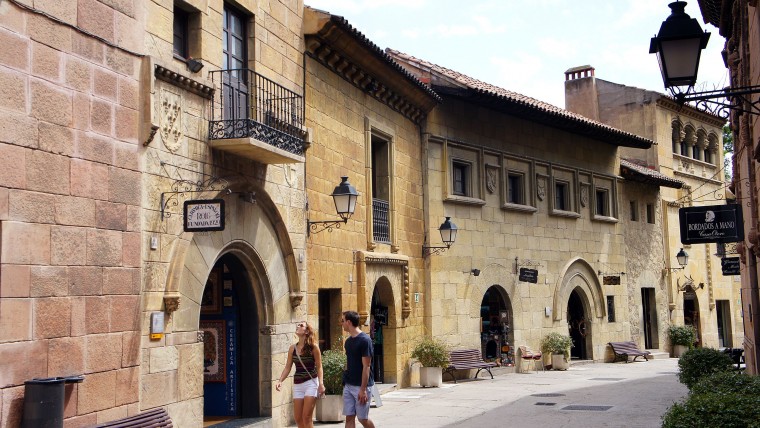
The streets and squares of Poble Espanyol form an open-air architectural museum, with 117 buildings that represent the diversity of the different communities in Spain. Created for the Barcelona International Exposition of 1929, Turisme de Barcelona says it is one of the most visited destinations in the city.
Travel across the Peninsula
Located on one of the sides of Montjuïc Park, not far from the Magic Fountain, is Poble Espanyol, an open-air architectural museum. It dates back to 1929, when architect Josep Puig i Cadafalch designed it as one of the attractions for the Barcelona International Exposition.
Designed to be a real town, with 117 buildings that represent the typical architectural features of different parts of the Iberian Peninsula, he reproduced true-scale versions of important streets, squares and buildings from across the peninsula. In this way, his design brings together typical constructions from the various regions of Spain, and visitors can stroll seamlessly from a Castilian square to an Andalusian street and enjoy the characteristic atmosphere of each place.
A project with a long life
Its harmonious, global features aim to represent what could be an ideal model town for the Iberian peninsula with all the diversity that entails. The project, which was supposed to run for six months, was such a huge success that in the end it stayed open and today attracts thousands of tourists and visitors every day who go there to discover one of the
most iconic destinations on Montjuïc.
It is one of the top 10 most visited tourist destinations and, in addition to the architecture, it offers typical food and handicrafts from each of the places represented.




Urban spaces
-
Sants-Montjuïc
el Poble-sec
-
- Phone number
- Tel.: 935086300
- Fax: 935086333
-
- Web
- http://www.poble-espanyol.com Open in a new window
-
- E-mail
- info@poble-espanyol.com
- inforeserva@poble-espanyol.com
-
- Accessibility
- Accessible for people with physical disabilities
- Address:
- Avinguda de Francesc Ferrer i Guàrdia, 13
- Districte:
- Sants-Montjuïc
- Neighborhood:
- el Poble-sec
- City:
- Barcelona
Timetable
| Dies | Hores | Preus |
|---|---|---|
| Dilluns i 24 desembre |
de 10.00 h a 20.00 h | Entrada general de: 0 a 15 € .Entrada general 13.50 € (online) -15 € (taquilles) .Entrada infantil (nens de 4 a 12 anys : 9 € (online)- 10 € (taquilles) Pack 2 adults+2 nens: 40 € Menors 4 anys: Entrada gratuïta Tarifes Especials a taquilla
Entrada gratuïta: · 24 setembre (festes de la Mercè) |
| Dimarts, dimecres, dijous, divendres, dissabte i diumenge excepte 24 desembre, 25 desembre i 1 gener | de 10.00 h a 00.00 h | |
| 25 desembre | de 10.00 h a 14.00 h | |
| 1 gener | de 13.00 h a 20.00 h |
L'accés adaptat a discapacitats és per la porta principal.
Les visites organitzades cal concertar-les.
Arquitectes: Ramon Raventós, Miquel Utrillo, Xavier Nogués, J. Montaner, F. Folguera, F. García Sanchiz (any 1929).
Esdeveniments
-
15è Festival de Titelles de Barcelona al Poble Espanyol Open in a new window
From 22/03/2025 to 23/03/2025
-
Festival "Guitar Bcn 2025" Open in a new window
From 17/01/2025 to 25/07/2025
-
Festival Empremtes 2025 Open in a new window
From 11/01/2025 to 05/12/2025
-
Concert "Els Amics de les Arts" Open in a new window
25/07/2025
-
Concert "Alan Parsons Live Project" Open in a new window
28/06/2025
-
Concert "Wilco" Open in a new window
26/06/2025
-
Concert "King Gizzard & The Lizard Wizard" Open in a new window
From 23/05/2025 to 25/05/2025
-
Concert "Fangoria" Open in a new window
08/07/2025
-
Concert "The Cult" Open in a new window
27/06/2025
-
Concert "Raule" Open in a new window
12/07/2025
-
Concert "Madness" Open in a new window
04/07/2025
-
Concert "Residente" Open in a new window
14/07/2025
-
Concert "El Drogas + Ciclonautas" Open in a new window
09/05/2025
-
Concert "Parov Stelar" Open in a new window
07/07/2025
-
Concert "The Corrs" Open in a new window
29/06/2025
-
Concert "Los Tigres del Norte" Open in a new window
01/07/2025
-
Exposició "ExpoDinos" Open in a new window
From 22/02/2025 to 04/05/2025
-
Concert "El Kuelgue + Zoe Gotusso" Open in a new window
06/07/2025
-
Concert "Julieta Venegas + Rita Payés" Open in a new window
21/07/2025
-
Concert "Camila Cabello" Open in a new window
24/06/2025
-
Concert "La Vela Puerca + Rienda Suelta" Open in a new window
10/05/2025
-
Concert "Grupo Niche" Open in a new window
13/07/2025
-
Concert "NAFTA" Open in a new window
17/07/2025
-
Concert "Rag’n’Bone Man" Open in a new window
18/07/2025
-
Concert "Guitarricadelafuente" Open in a new window
From 02/07/2025 to 03/07/2025
-
Concert "Zahara + Natalia Lacunza" Open in a new window
05/07/2025
-
Concert "G-5" Open in a new window
16/07/2025
If you would like to make a correction related to this activity...
LET US KNOW
